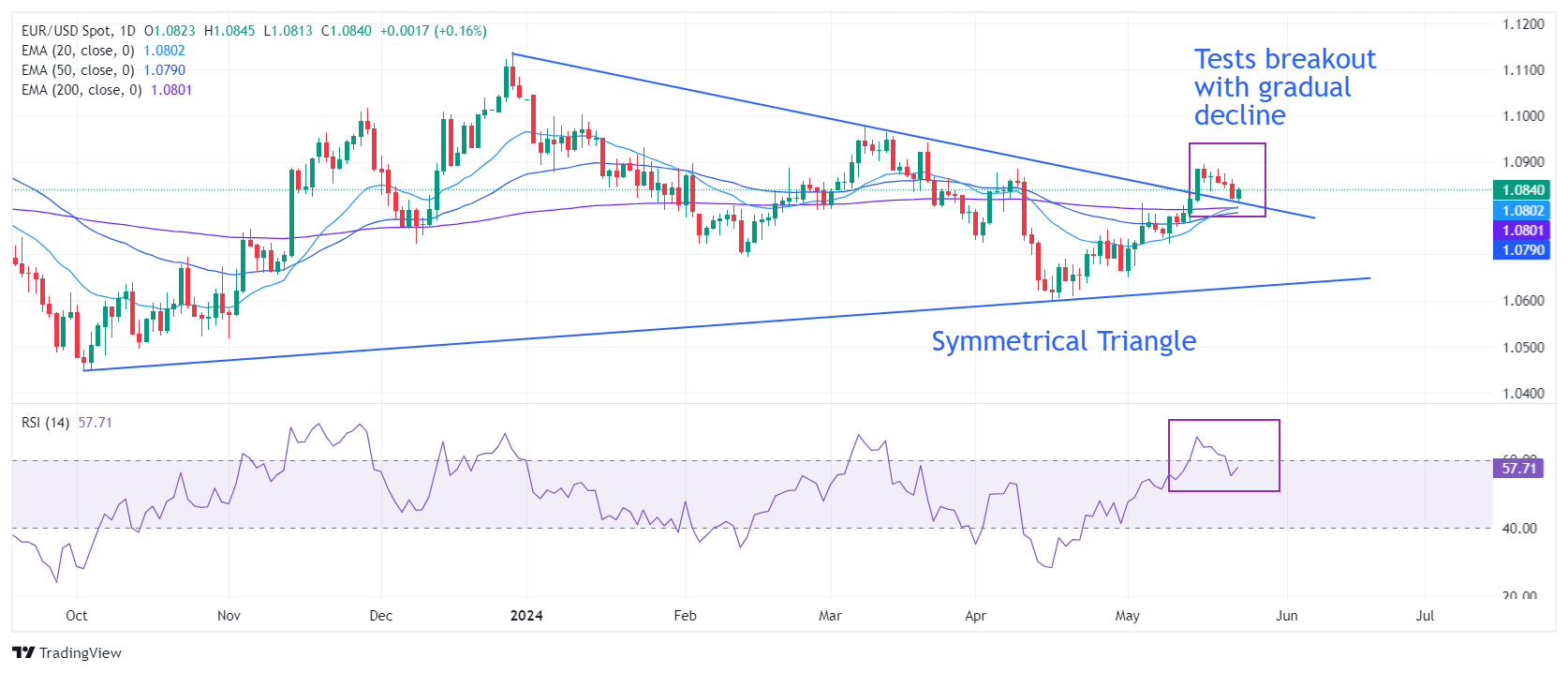- EUR/USD is trading above 1.0800 on positive preliminary Eurozone/US PMI data.
- The ECB is expected to cut interest rates three times by the end of the year.
- The outlook for the US dollar remains in doubt given the strong prospects for a Fed rate cut in September.
EUR/USD gave up most of its intraday gains in the U.S. market on Thursday. The major currency pair fell from an intraday high of 1.0860 after S&P Global released its flash U.S. Purchasing Managers' Index (PMI) for May. The agency showed that the manufacturing PMI rose to 50.9, beating expectations and the previous reading of 50.0. The services PMI, which measures the services sector, which accounts for two-thirds of the U.S. economy, rose to 54.8 from expectations and the previous reading of 51.3.
The strong US PMI readings suggest a stronger economic outlook for the US, pointing to strong labour demand and solid consumer spending. The agency commented, “The US economy is accelerating again after two months of slowing growth, with May PMI data showing the strongest growth rate in over two years. The data indicates that the US economy is back on track for another robust GDP increase in the second quarter.”
The US Dollar Index (DXY), which tracks the greenback's value against six major currencies, recouped all of its intraday losses and rose to nearly 104.90. However, the near-term outlook remains unclear as investors remain confident the Federal Reserve will start cutting interest rates from its September meeting.
Traders did not reduce their bets in support of a Fed rate cut in September, even though minutes from the May Federal Open Market Committee meeting released on Wednesday showed Fed officials making hawkish comments about the interest rate outlook.
The impact of the FOMC minutes on the US dollar was expected to be temporary, as officials were concerned that the deflation process would stall following three inflation spikes in January-March. Meanwhile, investors' firm speculation about a September rate cut is based on expectations of a decline in inflation data in the April Consumer Price Index (CPI) report.
Meanwhile, the U.S. Department of Labor reported that fewer people filed for unemployment benefits for the first time in the week ending May 17 than expected. Initial jobless claims came in at 215,000, below market expectations of 220,000 and below the upwardly revised figure of 223,000 from the previous 222,000.
Daily Digest Market Trends: EUR/USD remains firm on preliminary Eurozone and US PMI figures
- EUR/USD gave up most of the gains it gained from a strong flash euro zone HCOB PMI reading for May. The agency reported that the manufacturing PMI rose at a faster pace to 47.4, from the expected 46.2 and the previous 45.7. However, a reading below the 50.0 threshold is considered a contraction. The Composite PMI jumped to 52.3, beating the consensus of 52.0 and the previously released 51.7. The Services PMI, which measures the services sector, rose steadily to 53.3 but missed the 53.5 forecast.
- Commenting on the preliminary PMI data, Dr. Silas de la Rubia, Chief Economist at Hamburg Commercial Bank (HCB), said: “We are heading in the right direction. Taking the PMI figures into account in our GDP forecast, the euro area will put aside fears of a recession and grow at 0.3% in the second quarter. Growth is mainly driven by the services sector, whose expansion was extended to four months. Manufacturing plays an increasingly less role as a bottleneck for the economy, and optimism for this sector's future production is growing even more. With all this in place, GDP growth is likely to reach almost 1% this year, with even upside risks.”
- Going forward, the euro will be driven by market expectations that the European Central Bank (ECB) will cut interest rates when it meets in July. The ECB is widely expected to start cutting its key borrowing rate from its June meeting, leaving investors uncertain about further rate cuts by the ECB.
- Many ECB policymakers want to remain data-dependent on any rate cut in July, as aggressive monetary easing could reignite price pressures. They are also concerned that a rate cut could affect the balance between monetary stimulus, inflation and other monetary triggers.
- Financial markets expect the ECB to cut interest rates three times over the course of the year. Large financial services provider UBS said that according to its base case, the ECB could embark on a long, gradual cut in interest rates after the first cut in June, consisting of 25 basis points cuts per quarter, totalling 75 basis points in 2024 and a further 100 basis points in 2025.
Technical reasons why: EUR/USD remains firm above the triangle breakout area.

EUR/USD is showing great buying interest after testing the breakout area of the symmetrical triangle formed on the daily chart near the key support of 1.0800. The short-term outlook for this common currency pair remains strong as the 20-day and 50-day exponential moving averages (EMAs) made a bullish crossover near 1.0780.
The 14-period Relative Strength Index (RSI) is steadily moving within a bullish range of 60.00 to 80.00, suggesting momentum is trending up.
The major currency pair is expected to revisit its two-month high near 1.0900. A significant breakout above this high would send the asset rallying towards the March 21 high near 1.0950 and psychological resistance at 1.1000. However, a breakout below the 200-day EMA at 1.0800 could send it into the woods.
Economic indicators
S&P Global Composite PMI
The S&P Global Composite Purchasing Managers' Index (PMI) is released monthly and is a leading indicator of U.S. private business activity in the manufacturing and services industries. Data is derived from a survey of senior executives. Each response is weighted according to the size of the company and its contribution to the total manufacturing or services output of its subsector. Survey responses reflect the change (if any) in the current month compared to the previous month and can predict trends in official data series such as Gross Domestic Product (GDP), industrial production, employment, and inflation. The index ranges from 0 to 100, with a level of 50.0 indicating no change from the previous month. A reading above 50 indicates a generally expanding private economy and is a bullish sign for the U.S. dollar (USD). Meanwhile, a reading below 50 indicates a generally declining activity and is considered bearish for the USD.
read more.
Final Release: Thursday, May 23, 2024 13:45 (advance)
frequency: Monthly
Actual: 54.4
consensus: 51.1
previous: 51.3
sauce: S&P Global

